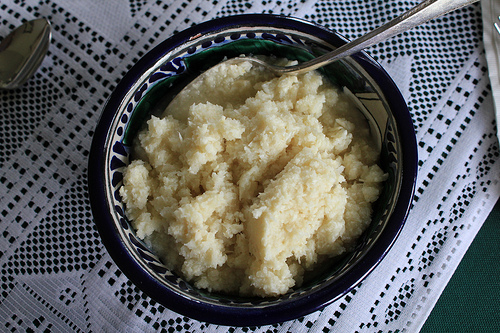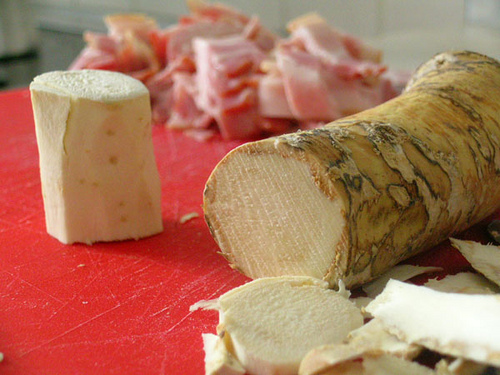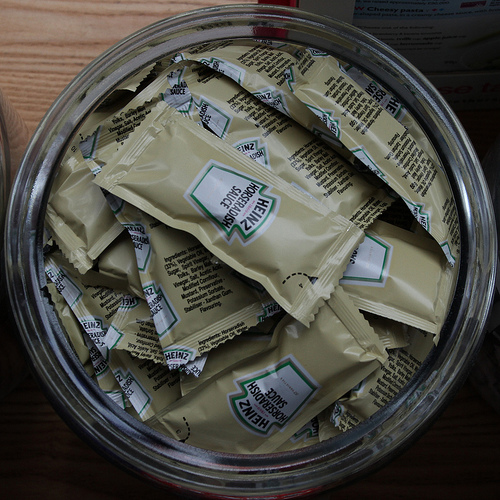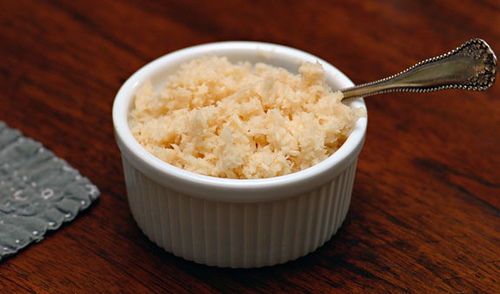All about: Horseradish
I love horseradish so much, but I have had to abstain ever since I switched to a low carb diet. I have yet to find a commercial horseradish preparation that doesn't include sugar, even though most actual recipes for horseradish don't add sugar. For some reason in America, we can't send anything out the door without sugar in it, though. And thus, commercial horseradish is sweetened. (Why though, seriously?)
This week I decided to finally buckle down and make my own horseradish. It turned out to be so easy that I wonder why I didn't try this sooner.

Image courtesy Flickr/Urban Sea Star
Horseradish history and botany
I am fairly immune to horseradish, even though I have a pretty good sense of smell and taste. Horseradish is a root vegetable in the brassica family, related to kale, mustard greens, turnips, daikon radish, and other hearty vegetables. It grows quite well in temperate regions - almost too well, according to many gardeners.
Horseradish has been cultivated and prized for its pungent bite for thousands of years. It was cultivated in ancient Egypt, and revered by the ancient Romans as a medicinal herb. Pliny the Elder wrote that it was a cure for sores and ulcers.
Horseradish probably gets its name from a mistranslation of the German name from the plant. I also like to think that it's a really big radish: the horse of radishes, if you will.
The heat of horseradish comes from isothiocyanates, which are a type of mustard oil. Adding an acid (like vinegar) stabilizes the heat, both making it more mild and keeping it fresh for longer. Thus, while sugar is an entirely discretionary addition to homemade horseradish, adding vinegar is critical.

Image courtesy Flickr/Iban
Buying horseradish
There are a lot of horseradish sauces you can buy at the store. My personal favorite is Beaver Brand extra hot creamy horseradish sauce.
If you want to make your own horseradish, look for horseradish roots. My local Safeway store sells them whole in the refrigerated "weird stuff" corner of the produce aisle, near the ginger root and whole hot peppers. The horseradish root has a brownish, woody skin, and is about the size of a large, strange carrot.

Image courtesy Flickr/Leo Reynolds
Make your own horseradish sauce
A lot of people make their horseradish sauce outside, due to the pungent fumes. Carry your cutting board and food processor out to the patio with an extension cord, or just open a window in your kitchen.
The first step is to peel and cube the horseradish. Damaging the horseradish cells is what releases the oil, so slicing it up isn't too bad, particularly if you use a good sharp knife. I found that the woody outer layer was too tough for a vegetable peeler, so I peeled it by hand with a paring knife. Next, dice it up into chunks that your food processor can handle.
Note: if you don't have a food processor, you can do it the old-fashioned way, with a hand grater. You still need to peel the horseradish, but don't cube it up, just grate it whole. I strongly recommend doing this outside, since you will be more closely exposed to the fumes.
Next, blend up your horseradish with a splash of water and some salt. The heat will continue to develop until you add the vinegar, which "fixes" the heat at that point. But be careful: if you wait too long (more than about 5 minutes) the horseradish will darken, lose its potency, and become "unpleasantly bitter-tasting."
I was a chicken, and added a splash of vinegar before I first pulsed it in the food processor. This resulted in a horseradish puree that was a little more mild than I would like. Next time I will be more bold.
Scoop the horseradish into a jar for storage. It will keep in the refrigerator for 3-4 weeks. You can use it either as is, or mixed with a dollop of mayonnaise to make a sauce.

Image courtesy Flickr/TheDeliciousLife
Using horseradish
My favorite use for horseradish is, hands down, with roast beef. In fact, that's what sparked my horseradish craze this week: I bought a chuck roast on sale, which I plan to roast in the slow cooker. It also goes well with bratwurst and Polish sausage.
Horseradish is excellent on sandwiches as an alternative to mustard. It also adds a powerful zip to otherwise bland dishes like mashed potatoes.
Main image courtesy Flickr/elana's pantry
